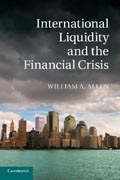
In the ongoing financial crisis, policy makers have for the most part appeared to be reactive, formulating emergency solutions as events unfold. However, in contrast to their performance during the Great Depression, central banks around the world, led by the Federal Reserve, acted decisively following the collapse of Lehman Brothers and provided huge injections of liquidity into the financial markets, thereby preventing a far worse outcome. International Liquidity and the Financial Crisis compares the 2008 crisis with the disaster of 1931 and explores the similarities and differences. It considers the lasting effects of the crisis on international liquidity, the possibilities for an international lender of last resort, and the enlargement of the International Monetary Fund after the crisis. It shows that there is no clear demarcation between monetary and macro-prudential policies, and discusses how central banks need to adapt to a new environment in which global liquidity is much scarcer. INDICE: 1. Introduction; 2. The domestic liquidity crisis in the USA; 3. International liquidity crises outside the USA; 4. Effects on financial markets outside the USA; 5. The theory of central banking before the crisis and the practice of central banking during the crisis; 6. Swap lines; 7. Which countries received swap lines?; 8. Did the swap providers achieve their objectives?; 9. How did the swap lines affect the recipients?; 10. Propagation and scale of the 1931 crisis; 11. The management of the 1931 crisis; 12. A comparison of 1931 and 2008; 13. International liquidity management.
- ISBN: 978-1-107-42032-8
- Editorial: Cambridge University Press
- Encuadernacion: Rústica
- Páginas: 270
- Fecha Publicación: 03/04/2014
- Nº Volúmenes: 1
- Idioma: Inglés
